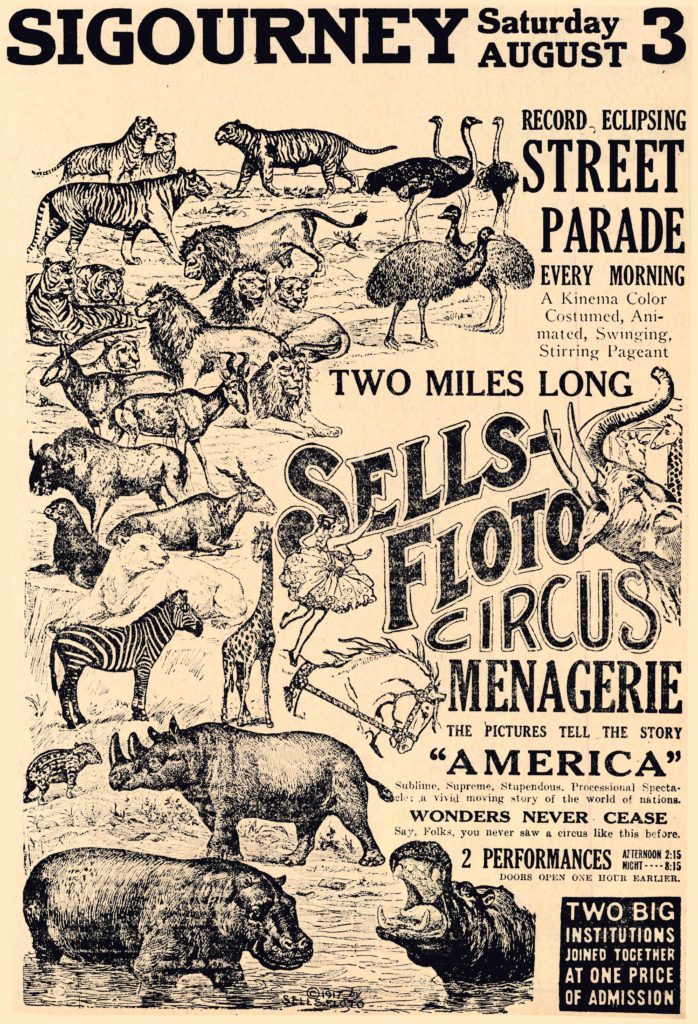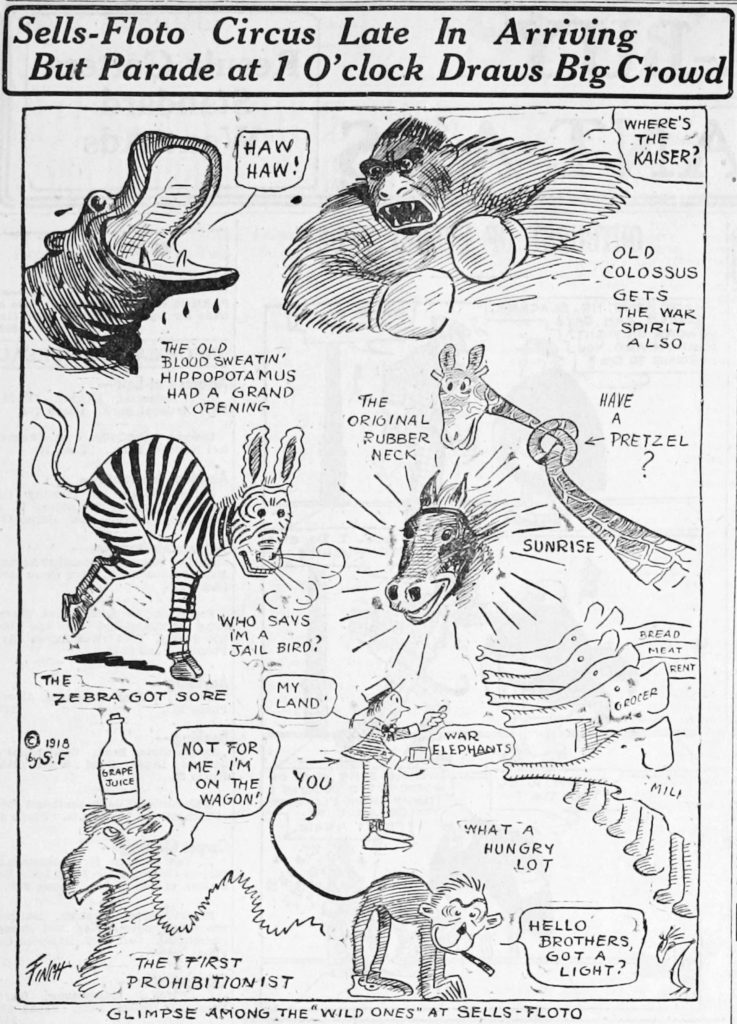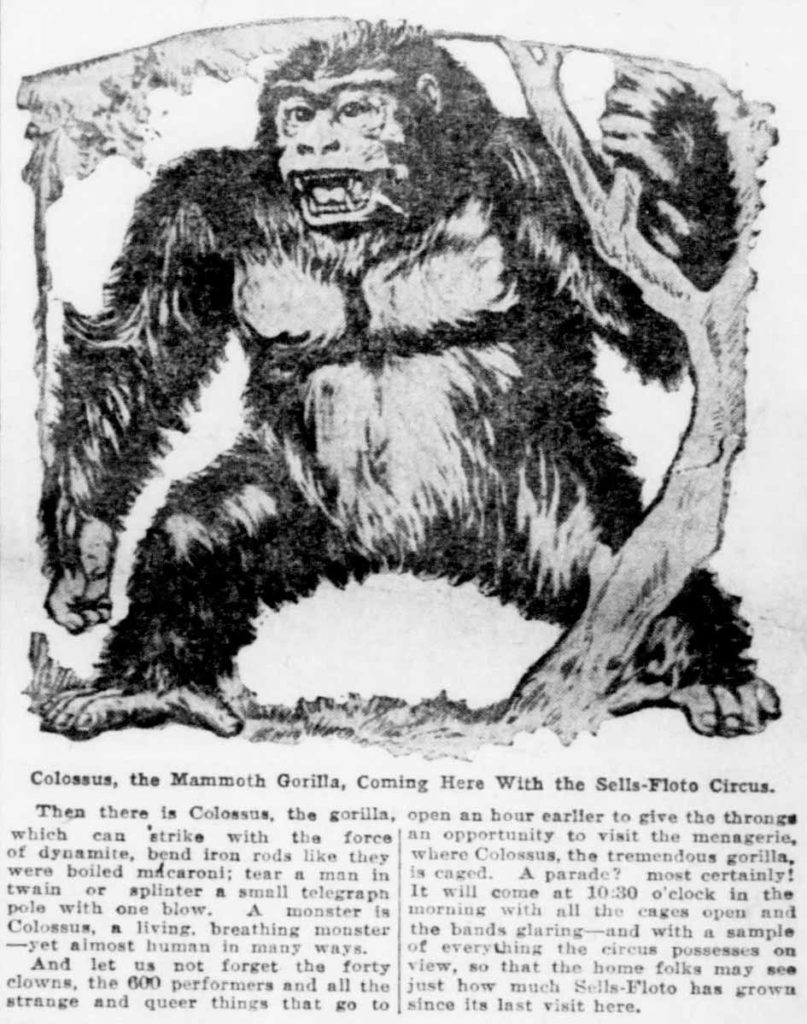
The Death of a Circus Gorilla In Sigourney, Iowa
What’s a circus without exotic animals? In the heyday of circus culture, many circuses had a menagerie, which featured exotic animals like elephants, tigers, lions, zebras, hippopotamuses, rhinoceroses, snakes of all kinds, and of course, gorillas. Gorillas were the prime exhibit of most circuses that had them and there have been a few notable ones over the years such as Gargantua the Great who saved the Ringling Brothers Circus from bankruptcy. Rather than talk about Gargantua, I’m here to discuss his lesser known predecessor, Colossus, the ill fated circus gorilla who met his end to tuberculosis in Sigourney, Iowa.

Source: The sigourney news review
In early 1918, the Sells-Floto Circus was preparing for its upcoming tour of the western United States. The circus was owned by Harry Heye Tammen and Frederick Gilmer Bonfils. The two started the circus in 1902, originally called the Floto Dog and Pony Show. Tammen and Bonfils hired William Sells to manage the circus in 1906 and later renamed it to the Sells-Floto Circus that same year, not after William Sells but after the popular Sells Bros. Circus and after Denver Post sports journalist, Otto Floto. They began their 1918 tour in Albuquerque, New Mexico on April 6th. They would do shows in New Mexico and Texas before moving west for shows in Arizona and California. On Tuesday, April 23rd, 1918 the circus was in San Bernardino and while there acquired their big act: Colossus, a nine year old gorilla, who Tammen acquired after a near world-wide search. He weighed 205 pounds and stood five feet tall. Tammen had arranged some months prior to purchase Colossus from a zoo in town as the circus had already advertised the gorilla as part of the show from San Bernardino onward. Unfortunately, Colossus began to lose weight almost immediately after being placed in the care of the circus. As the circus continued on its route, Colossus became more and more sick and more and more violent. He would shake his cage with enough force to tip it over, resulting in the cage being chained to the floor, and on May 13th, while in Modesto, California, he severed part of his keeper’s hand. As the circus approached Iowa, Colossus was likely on his death bed. His final day was spent in Sigourney, Iowa on Saturday, August 3rd, 1918. By then he weighed 140 pounds, losing an average of 20 pounds per month while in the possession of Sells-Floto. The circus did a show at 2:15 Saturday afternoon but it’s unknown if Colossus was exhibited due to his health. By 6 pm he was dead, losing his long battle with tuberculosis. Henry Gentry, the circus president and manager, arranged for his body to be embalmed at Baylor’s Undertaking Parlor. It remained there for two days and several hundred people observed his body. Apparently, a better view could be obtained of Colossus while dead rather than while alive and on exhibition. He was shipped to the Denver Post in Denver, Colorado on Monday, August 5, 1918 after being on exhibition in Baylor’s for two days.

Source: Albuquerque morning journal
H.H. Tammen, one of the owners of the circus, would have him stuffed by a taxidermist and placed in a museum. It is unknown what museum Colossus was placed in or where he is today.
Several newspapers in Iowa reported on the news of Colossus’ passing. The Evening Journal, in Washington, Iowa published the following: “The reason that you didn’t see the famous Gorilla with the circus yesterday was due to the fact that this specimen of our ancestry had passed to the great beyond while in Sigourney. Sigourney was more than he could stand. He was embalmed and returned to the place from where he came. This is not criticism on our part, but we believe a Leonard refrigerator might have saved his life”. Eventually Sells-Floto ceased to advertise Colossus to future stops. His final appearance was in The Fairfield Daily Journal on August 16th, 1918.

Source: The Great Divide
qualities. According to an article by the Sigourney News, “This animal resembled a human being in many respects. Its ears and fingers especially were quite similar to those of a man.
With the exception of length, a striking resemblance could again be found in the arms. The gorilla’s arms were approximately 12 inches longer than those of the average man. According to statements made by the manager of the circus, the comparison is further justified, in regard to its food and its manner of eating. It is said that at one time the keeper gave the animal a dish of blackberries and cream, and the result was that very human traits were displayed, as it made way with the fruit. It was also fond of smoking cigars and cigarettes.” It would be plausible that his death of tuberculosis had something to do with his consumption of cigars and cigarettes. This information can also be used to give consideration to the quality of life that he would’ve received in the captivity of the circus and that it may have not have reached the standards of care gorillas in captivity receive today.
The story of Colossus the Gorilla doesn’t end here though. It has been discovered that he may have been falsely represented all these years. It is believed that he was never a gorilla but a chimpanzee. The circus portrayed him as a gorilla though. Gordon M. Carver, a writer for Bandwagon Magazine, writes an explanation for this as the following: “However, Colossus was actually not a gorilla, but a large nine year old chimpanzee. But he was big and the show could be sure that only rarely would anyone suspect or know that he was not actually a gorilla”. The circus also described Colossus as standing 7 feet 8 inches, a height far exceeding the average height of an adult gorilla. Upon closer examination, it’s revealed that he was listed at that height with “hands up”, a bit misleading but not untrue. The circus would also claim Colossus to be the “only full grown gorilla ever to live in captivity”. That claim is difficult to prove because there may have been other full grown gorillas living in captivity at that time. Also taking advantage of people who had never seen such a creature before, they described him as “half man, half beast- scientific mystery of creation – walks upright like a man; crumbles bricks in one hand…”. While the research surrounding primates was not as concrete as it is today, there is some exaggeration in that statement, but people who had never seen a gorilla might have had the same sentiment when observing Colossus for the first time. Those kinds of claims are not unusual for a circus to make, they are well known for their colorful gimmicks and taglines- it’s how they get people in the door.
Another theory is that Colossus was in fact a gorilla but a female one. That would explain its weight; an adult female weighs around 159-216 pounds. If Colossus were nearing maturity, its listed weight of 205 pounds would be plausible of that of an adolescent. This can also be used to rule out the possibility of Colossus being a chimpanzee on the basis of weight as an adult male chimpanzee weighs up to 132 pounds.
So the story of Colossus ends here. His story is one of peculiarity and one of the many examples of showbiz exaggeration. His current whereabouts are not known but I’d like to think that he brings delight to the faces of children in a museum somewhere, we may never know.
Thanks for reading this very unique episode of Homegrown Stories. If you would like to learn more and watch my corresponding video on YouTube, just search for Black Oak Films. I’ll catch you next time!
I would like to thank Rick Tollenaar at the Keokuk County Historical Society for bringing this story to my attention.





